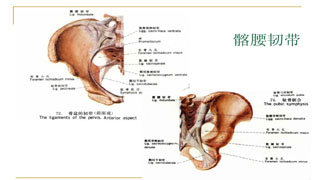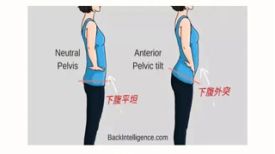
The main causes of injury to the iliopsoas ligament are excessive flexion, torsion, or lateral bending of the waist, with acute injuries being more common. The main pathological changes in the chronic phase of iliopsoas ligament injury are loss of balance in the waist 4 and 5, and stiffness in the waist.
What is iliopsoas ligament
The iliolumbar ligament is a very deep and important ligament that serves as the attachment site between the lower side of the lumbar muscle and the upper side of the iliopsoas muscle.
The medial side of the iliopsoas ligament is attached to the transverse processes of the lumbar vertebrae at L4 and L5, while the lateral side is attached to the iliac fossa, iliac spine, and sacrum. It is almost impossible to see this ligament from the posterior side during dissection. It is buried under the skin, superficial fat fascia, deep muscle fascia, thoracolumbar fascia, and erector spinae muscle. In the abdominal cavity, the iliopsoas ligament can be found on the posterior side and is an important component of the posterior abdominal wall.
The iliopsoas ligament is a wide and thick triangular fiber bundle that extends between the transverse processes of the fourth and fifth lumbar vertebrae, as well as between the iliac crest and the anterior part of the upper iliac bone. Its fibers originate from the lower edge of the transverse process of the fourth lumbar vertebra and the transverse process of the fifth lumbar vertebra, radiating to the inner lip behind the iliac crest, equivalent to the deep layer of the lumbar fascia. The iliopsoas ligament is a thickened part covering the pelvic fascia of the quadratus lumborum muscle, and its inner side is mixed with the intertransverse process ligament and the sacroiliac posterior short ligament. This ligament is actually an important tissue in the lower limbs that supports the weight of the upper body of the human body. It can limit the rotation of the waist 5 while preventing it from sliding forward on the sacrum.
These connections on the anterior side make the iliopsoas ligament particularly important for establishing appropriate intra-abdominal pressure. The upper bundle of ligaments is attached to the anterior layer of the thoracolumbar fascia, thus assisting in transmitting the force generated by the deep core muscle group connected to the anterior layer of the thoracolumbar fascia.
These muscles include the multifidus, erector spinae, transversus abdominis, and internal oblique muscles. This means that the iliopsoas ligament can store the kinetic energy of the deep core muscle group used to generate intra-abdominal pressure and transfer it to its attached tissues, such as the quadratus lumborum and iliopsoas muscles. This can explain why the lack of intra-abdominal pressure generated by the deep core muscle group can lead to a loss of power distribution from the lumbar muscles to the lower back and from the iliac muscles to the hip joint.
The connection between the deep and shallow cores, as well as the hip joint muscles, assists in the stable transfer of the trunk to hip joint activity and assists in the step phase of gait, including hip elevation caused by the quadratus lumborum muscle, hip flexion caused by the iliopsoas muscle, and even more shocking, the iliopsoas ligament is actually a muscle. Until the fifth decade of life, the iliopsoas ligament has nerves and blood vessels branching out from the lumbosacral nerve trunk and iliac artery, becoming an important transition zone from intra-abdominal pressure to walking. This ligament usually has iliac inguinal nerves and lateral femoral cutaneous nerves on its surface, which may cause transfer pain to the outer thigh or groin.
The literature points out that this ligament also has pain and proprioceptive abilities. On the one hand, it has the ability to hinder walking and the ability to generate pressure, and on the other hand, it supports correct posture and force transmission during walking.
If the erector spinae or iliopsoas muscles are tense for a long time, it is possible to consider their association with the deep core muscles through this ligament.
Symptoms of iliopsoas ligament injury
Although the iliopsoas ligament is a strong and powerful ligament, it plays a pivotal role in trunk movement and is also the most easily injured ligament in the waist. Many patients with lower back pain in clinical practice actually have problems with the iliopsoas ligament. And a crucial point is that we need to repair or strengthen the iliopsoas ligament, enhance the self-protection of the waist, and reduce recurrence. If one frequently bends over, bears excessive weight, has excessive torque, exerts improper force, sits for long periods of time with poor posture, is subjected to strong external impacts, or even lacks exercise and abdominal and back muscle strength, it will increase the chance of local damage to the iliopsoas ligament, making it one of the most common causes of back pain.
The iliopsoas ligament has a thick and tough triangular shape. In general, even if subjected to strong violent injuries, it will not completely break, only local injuries will occur. It is a strong structure that stabilizes the 4th and 5th lumbar vertebrae, making the connection between the ilium and the 4th and 5th lumbar vertebrae more stable.
The fourth and fifth lumbar vertebrae are the focal points of stress in the human trunk. During lumbar extension, flexion, and scoliosis, the iliopsoas ligament is affected by corresponding stress, so iliopsoas ligament injuries are more common in clinical practice. In spinal rehabilitation treatment, the iliopsoas ligament mainly plays a key role in stabilizing the 5th lumbar vertebra and pelvis, preventing lesions such as 5th lumbar spondylolisthesis or pelvic anterior tilt and displacement during spinal rehabilitation. However, due to the fact that the iliopsoas ligament is hidden between the transverse processes of the 4th and 5th lumbar vertebrae and the inner side of the iliac crest, covered by bony tissue, the pain site after the lesion is deep and cannot be touched, which brings certain difficulties to diagnosis and treatment. In clinical practice, it is easy to be misdiagnosed due to unclear diagnosis.
Clinical symptoms: Deep pain on both sides or one side of the fifth lumbar vertebra, and the patient can only point out the location of the pain without indicating the obvious pain point. Lower back flexion and extension, lateral flexion, and limited rotational movement. Lifting heavy objects can easily cause severe pain.
Diagnostic criteria: 1. History of lumbar trauma or strain injury. There is deep tenderness at the iliac angle between the lateral edge of the 4th and 5th lumbar vertebrae and the iliac crest. The patient was seated and turned towards the back of the affected side, causing increased pain in the iliopsoas ligament. Exclude other diseases
Excessive twisting is the main cause of injury
Iliopsoas ligament injury is mainly caused by excessive bending, twisting, or scoliosis of the waist, and is mainly manifested as deep pain on both sides or one side of the fifth lumbar vertebra. The patient can only point out the location of pain, but there is no specific pain point, accompanied by lumbar flexion, lateral flexion, and rotational movements, which can easily cause severe pain when lifting heavy objects.
In clinical practice, acute injury of the iliopsoas ligament is more common, accompanied by pain attacks. If left untreated, it can become chronic dull pain, which occurs after work and improves after rest. Chronic strain of the iliopsoas ligament is more common in workers who have been engaged in excessive bending for a long time.
Treatment of iliopsoas ligament injury
There are many clinical treatment methods for iliopsoas ligament injury, and mild cases mainly rely on rest and functional exercise to improve symptoms; When severe cases often cause significant daily activity disorders, specific treatment is needed.
Clinically, the treatment of this disease is mainly conservative, including regular cooperation with massage manipulation to release muscle fascia, acupuncture and moxibustion treatment to dredge the meridians, and Chinese medicine to regulate yin and yang, tonify the liver and kidney, so as to alleviate pain and improve the lumbar function. If there is severe tearing or rupture of the iliopsoas ligament, surgical evaluation should be performed, and if necessary, surgical intervention can be performed for treatment.
In addition, in daily life, patients should consciously exercise to strengthen the iliopsoas ligament, and release it in a timely manner after exercise or labor to avoid injury to the iliopsoas ligament.


